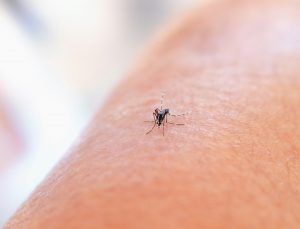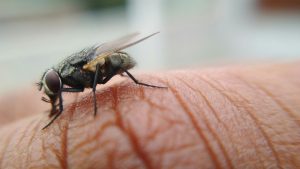Protecting yourself against insect bites is important, not just when you’re travelling, but also during the summer months in Canada. While it’s true that mosquito-borne diseases like malaria, dengue fever, yellow fever, chikungunya, and Zika are a risk in tropical regions, Canada isn’t without its own risks. Serious insect-borne diseases such as Lyme disease and West Nile virus are a growing concern in Canada as well. And on top of that, no one wants to deal with the itch and irritation of insect bites during the summer!
One look at the bug spray aisle and it’s clear that choosing a good insect repellent isn’t as simple as it sounds. DEET, icaridin, permethrin, oil of lemon eucalyptus, citronella, essential oil blends—there are so many active ingredients to choose from! Then there’s the question of format: bug spray, aerosol, lotion, or wipes? And what about newer alternatives like mosquito patches, stickers, clip-on products, and bracelets?
In this blog, I’ll break down the different types of insect repellents to help you choose the best option for your needs.
Understanding Active Ingredients
DEET (N,N-Diethyl-m-toluamide)
Examples: Ben’s, Watkins, CarePlus Deet, OFF Deep Woods Sportsmen (30% DEET)
Deet is considered the gold standard for insect repellents. It is effective against mosquitoes, ticks, fleas, black flies, deer flies, and chiggers. DEET has been in use for more than 50 years and is the most widely used and studied insect repellent worldwide. DEET is safe when applied as directed and in the right concentration, depending on age.
Products range from 5% to 30% for general use. Higher concentrations (up to 100%) offer longer protection but aren’t necessarily more effective (only up to 30% is available in Canada).
Recommended concentrations:
• Adults: up to 30% (30% DEET recommended for travel to tropical destinations)
• Children aged 6 months – 12 years: up to 10% DEET
Best for: High-risk areas or when spending long hours outdoors.
Potential downsides:
• Mild skin or eye irritation
• Strong smell and greasy feel
• Potential to damage certain materials like synthetic fabrics, plastic, leather, or vinyl
• Can damage aquatic life; not reef friendly

Icaridin, also known as Picaridin (1-piperidinecarboxylic acid 2-(2-hydroxyethyl)-1-methylpropylester)
Examples: Natrapel DEET-Free, OFF Deep Woods DEET-Free, Piactive, CarePlus Icaridin
Icaridin is just as effective as DEET against mosquitoes and ticks, but is relatively odourless, non-greasy, and less likely to irritate skin or damage synthetic materials. Icaridin is the preferred insect repellent for infants and children aged 6 months – 2 years, and for those with sensitive skin.
Recommended concentration: available in concentrations of 20%
Best for:
• high-risk areas or when spending long hours outdoors
• children 6 months of age and older
Downside: Like DEET, icaridin is not reef-friendly.
Permethrin
Permethrin is not for use on skin but is a powerful insecticide and repellent when applied to clothing, hats, shoes, mosquito nets, outerwear, and camping gear. Adults, including pregnant women, can wear permethrin-treated clothing, but it is not approved for children under 16 years of age.
Available in: Pre-treated clothing (0.5% permethrin). Permethrin sprays are not sold in Canada, but pre-treated items can be found at retailers such as Canadian Tire, Marks, and online.
Effectiveness: Lasts through several washes (up to 70) —check the label.
Natural Insect Repellents
Oil of Lemon Eucalyptus (PMD) offers good protection against mosquitoes and black flies but needs to be applied more often than DEET or icaridin. It is not recommended for children under 3 years old.
Soybean Oil provides short-term protection against mosquitoes and blackflies. Suitable for all ages.
Essential Oil Blends (e.g., lemon, citronella, camphor, eucalyptus, lavender, peppermint, geranium) can be used to repel mosquitoes for brief periods of time. These can cause allergic reactions or skin irritation and shouldn’t be used on children younger than 2 years old.
Choosing the Right Format
Sprays and Aerosols
• Pros: Easy to apply, good for covering large areas of exposed skin or clothing.
• Cons: Can be inhaled during application; may not be ideal for small children.

Lotions and Creams
• Pros: Allow for more controlled, even application.
• Cons: Can feel greasy depending on the formulation, or difficult to apply on sweaty skin.
Wipes
• Pros: Convenient for travel, easy to apply to face.
• Cons: Less coverage, more waste, less economical
Wearable Devices (e.g., bracelets, stickers, patches, clip-on devices)
Bracelets, Stickers, and Patches generally work by slowly releasing various essential oil scents. Clip-On Devices use a fan to circulate a chemical (metofluthrin) or essential oils to repel mosquitoes.
• Pros: No skin contact with chemicals.
• Cons: Do not protect well against insect bites, and are not as effective or as long-lasting as repellents applied to skin. These types of devices should not be used as your only repellent.
Takeaway Message
Choosing the right insect repellent depends on your specific needs—whether you’re at home in Canada or travelling abroad, spending a short evening outdoors or trekking through a high-risk area. Look for a product that matches your exposure level, skin sensitivity, age group, and environmental concerns. DEET and icaridin remain the most reliable options for protection, while natural products may be suitable for short-term use in low-risk settings. Always read the label and apply products as directed. When in doubt, especially for travel, consult your travel health specialist at TMVC and book a travel consultation. A little preparation goes a long way in making sure your time outdoors stays bite-free and enjoyable.
